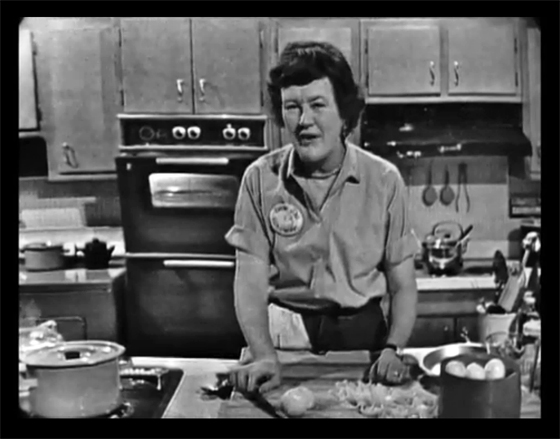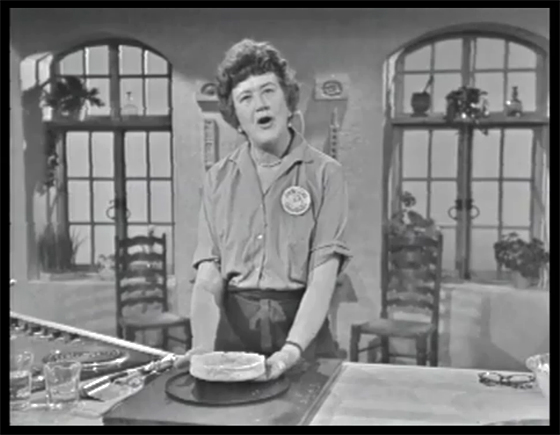
Julia Child on The French Chef making French Onion Soup
Julia Child would have been 100 years old this month. In her honor, KQED and PBS will be celebrating her centennial in the weeks leading up to her birthday on August 15. Thinking about Child's many contributions to the way we eat, talk, and think about food, it's instructive to go back to see how her original television show, The French Chef, became a hit. In its cookbook tie-in, The French Chef Cookbook, Child explains the unexpected way that her fifty-year career in television got its start.
All it took were twenty-seven letters sent to the studios of Boston's public television station, WGBH-TV. At the time Mastering the Art of French Cooking was published, a Parisian friend of the Childs, Beatrice Braude, was working at the station. Braude suggested promoting the book with an appearance by Julia on one of the station's book-review programs. Julia agreed, and hoping to "liven things up a little," arrived for her interview bearing a dozen eggs and an eye-catchingly huge copper bowl. During the talk, Child pulled out a whisk, grabbed her enormous bowl, and showed how the right flick of the wrist could turn a few egg whites into a mountain of billowing froth. Much to everyone's surprise, more than two dozen viewers wrote in, asking for more from the French chef with the flutey voice and American attitude.

Julia Child on The French Chef making French Tarts, Apple Style
This was the early 1960s. French chef Rene Verdon was cooking in the White House. First Lady Jacqueline Kennedy spoke French to European heads of state while wearing Chanel and Givenchy. Jet travel was booming; suddenly, for those who could afford it, a trip to Europe meant a few hours on a plane, not a week on a ship. In the right place at the right time came Julia, an indomitable, sunny-faced Californian able to translate the elegant mysteries of French cuisine for television-watching, supermarket-shopping Americans. WGBH asked Julia if she'd like to try making three pilot shows, each thirty minutes, demonstrating the French way of cooking. Julia agreed, only to find out that the station's studio had burned to the ground a few months before. They found makeshift accomodation in a display kitchen at the Boston Gas Company. Equipment was loaded into the Childs' station wagon, unloaded in the gas company's lobby, and with barely a rehearsal, the first show was taped. As Child wrote,
It was out of the question for us to film a live show since we had only two cameras attached by long cables to a mobile bus. Besides, with an absolutely amateur performer, it would have been far too risky. We decided, however, that it would be taped as though it were live. Unless the sky fell in, the camera failed or the lights went off, there would be no stops, and no corrections--just a straight thirty minutes from start to finish. This was a good fundamental decision, I think. I hate to stop. . . Besides, I would far prefer to have things happen as they naturally do, such as the mousse refusing to leave the mold, the potatoes sticking to the skillet, the apple charlotte slowly collapsing. One the secrets of cooking is to learn to correct something if you can, and bear with it if you cannot."
Watching that first show, which aired on July 26, 1962, Child wrote,
There was this woman tossing French omelettes, splashing eggs about the place, brandishing big knives, panting heavily as she careened around the stove, and WGBH-TV lurched into educational TV's first cooking program."
Because the genre was so new, the station gave Child free rein to develop the show her own way, without focus groups or media training.The show found a semi-permanent home in the Cambridge Electric Company's display kitchen, located in a spacious loft that, conveniently, had three entrances: a front stairway, a freight elevator, and a fire escape descending into the parking lot.
Nobody at WGBH had the slightest idea what we were cooking in our loft until the cameras were lugged up the outside fire escape at 10 o'clock on Wednesdays and Fridays to beging the tapings. . . [Assistant Producer] Ruth Lockwood and I had complete freedom to work up anything we wished and to present it in any manner we chose."
Since this was educational television, however, Child wanted "to demonstrate that [French cooking] is not merely good cooking, but that it follows definite rules...I, myself, will not do anything unless I know why." She didn't just sauté and flambé, she explained the whys and hows for whipping egg whites, perfecting emulsions like mayonnaise or hollandaise sauce, or clarifying a stock, all as a means of "taking the bugaboo out of French cooking."